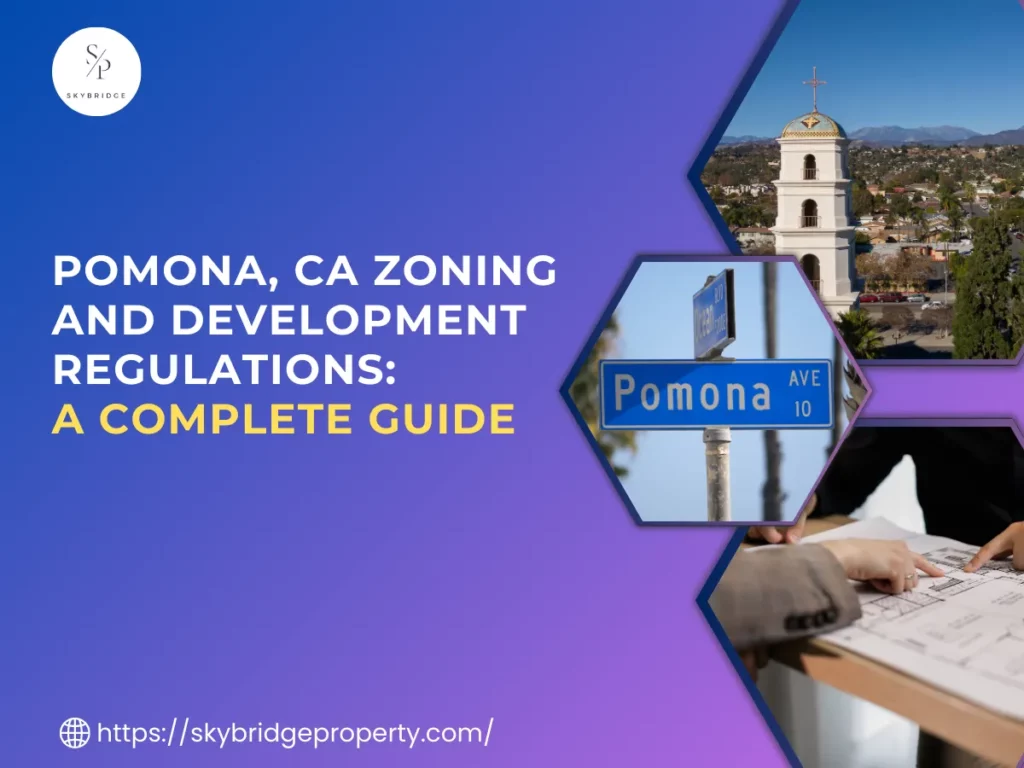Pomona is a city located in eastern Angeles County, California and between the Inland Empire and San Gabriel Valley. It is named after the ancient Roman goddess of fruit, Pomona by a horticulturist named Solomon Gates. With beautiful landscapes, rich history, and diverse culture, it is a perfect destination for outdoor activities like hiking, mountain biking, and skiing. This beautiful valley promotes green initiatives, renewable energy sources, and boosts programs to reduce water consumption.
It is home to Pomona Antique Row, Latino Art Museum, Fox Theater Pomona California Botanic Garden, the Fairplex Garden Railroad, and the George & Sakaye Artani Japanese Garden. With over 151,000 residents, Pomona is the seventh largest city in Los Angeles Country. Its core values are cultural diversity, Fiscal Responsibilities, Leadership, Excellent customer service, Focusing on the future, and Engaged compassion.
Now, California has become the birthplace of zoning with a local system that dictates how land in a town or city can be used. The main purpose of zoning laws is to divide land into four categories, agricultural, residential, commercial, and industrial. Apparently, this promotes orderly development by keeping control of noise, traffic flow, and activity levels in each specific neighborhood.
What are the Key Aspects of Pomona’s Zoning and Development Regulations?
The key aspect of Pomona’s zoning and development regulation is to balance growth while maintaining the city’s characteristics while meeting state requirements. The zoning law helps establish rules for land use to promote orderly development, enhance the city’s livability, and prevent land-use conflicts.
Zoning laws have broader economic and social implications for commercial real estate projects. With designated specific zones for different uses, these laws shape a neighborhood’s composition and vibrancy by separating industrial and commercial uses from residential, reducing traffic and noise, and improving livability.
Zoning regulations also shape commercial real estate markets by controlling where businesses can operate. For example, the CCPP Overlay District in Pomona which designates specific zones for commercial cannabis business is a perfect example of how zoning affects property values. Properties within this area may see increased or higher values due to the business, while, areas with strict zoning that limit mix-development may experience slower commercial growth.
The main objectives of zoning is public safety, efficient land use, and maintaining aesthetic value. Doing this prevents overlapping incompatible scenarios like having an industrial factory next to a house.
The recently updated zoning laws are designed to align modern urban planning with state mandates. The modernization of regulations is to allow commercial and residential development in the same areas promoting walkability while adjusted density controls is to support higher-density housing in transit-friendly areas and address housing shortages.
The alignment with state housing mandates and climate goals is to create more affordable housing units with integration of sustainable development practices. Lastly, simplified permit processes for developers streamlines approval times for new projects reducing administrative delays.
Zoning Districts
Zoning districts means an area or areas within the town limits for which the regulation and requirements governing use, lot and bulk of building and premises are uniform. Zoning affects the supply of housing and under the economic principle of supply and demand that makes the prices go up or down.
Residential Zones
Residential zones are single-family residences, suburban homesteads, and other living areas like houses, co-ops, condos, duplex, trailer park, and apartments. They cover issues such as the number of structures allowed on a property and whether mobile homes can be placed on property. Likewise, they also limit which and how many animals are allowed at a residence.
Commercial Zones
Commercial zones refer to any kind of real estate other than single-family homes and lots. It has several categories, depending on the business use of the property and the number of business patrons.
Some examples of commercial zones are office buildings, shopping centers, nightclubs, hotels, some apartment complexes, warehouses, and vacant land. There are rules and regulations regarding certain types of businesses like retail, office, and service industries. Likewise, many zoning laws restrict or limit activities in commercial zones.
Industrial Zones
Industrial zones are the groundwork for establishing warehouses, factories, and similar facilities within a defined area. It is critical for city planning as it separates areas with heavier and potentially disruptive activities from residential. Manufacturing plants and storage facilities with industrial zoning use permits whereas businesses like airports have their own designation.
Agricultural Zones
Agricultural zones are usually found in communities that are trying to maintain the farm industry’s economic survival. This allows a range of activities like crop production, livestock farming, dairy farming, horticulture, and farm-related structures. Some of the benefits of Agricultural areas are farming, nurseries, and limited residential use. The specific guidelines for development like permitted uses, accessory uses, minimum lot sizes, buffer zones, and restrictions on non-agricultural uses.
What are Overlay Districts in Pomona?
Overlay districts In Pomona are special zoning designations that modify land-use regulations to meet specific community needs like emergency shelters, housing, or even commercial cannabis businesses while maintaining overall zoning goals. These districts work alongside state laws like Senate Bill (SB) 330 which is also known as the Housing Crisis Act of 2019 and ensure zoning policies align with California’s efforts to address the housing crisis.
The SB 330 Overlay Zone in Pomona ensures compliance with the law by promoting housing development and preventing restrictions that could lower housing availability. SB 330 has made it easier for developers to move forward with residential projects and despite challenges like community pushbacks, SB 330 Overlay Zone has played a crucial role in facilitating Pomona’s housing growth while ensuring compliance with state laws.
The Emergency shelter overlay in Pomona allows emergency shelters to be built in specific areas without requiring a special permit or approval. This makes it easier to provide temporary housing for individuals seeking housing.
Besides this, Pomona has specific areas designated for commercial cannabis business to operate under the CCPP Overlay District. The city only permits 8 cannabis businesses with only 2 retail storefronts. These businesses must be at least 1,000 ft away from schools, parks, and other sensitive areas.
What are the Development Standards in Pomona?
Development standards in Pomona are physical controls and environmental requirements that guide ecological impact, building size, and placement. They regulate how properties can be developed and ensure environmental sustainability, orderly growth, and community compatibility.
Pomona’s development standards align with its broader development goals by balancing growth with community character, efficient land use, and environmental sustainability. Reducing sprawl by regulation building size, lot coverage, and placement help control urban expansion. By supporting eco-friendly infrastructure, preventing overdevelopment, and preserving natural features, it helps create a more livable, eco-friendly city with improves air quality.
The physical controls dictate the size and placement of buildings on a property to maintain safety and characteristics of the neighborhood. They restrict building over 35-foot height limit for residential zones and setbacks specify minimum distances like front yard distance from the street, rear yard space at the back of the property, and side yard space between neighboring properties.
The lot coverage ratio is for limiting how much a lot can be covered by buildings to prevent overcrowding. This also ensures proper drainage systems to prevent flooding and regulates tree removal and encourages planning to improve air quality and maintain urban greenery.
What is the Development Approval Process in Pomona?
The development approval process in Pomona ensures that construction projects comply with zoning laws, environmental standards, and building codes. The process involves multiple key steps like pre-application consultation, project application submission, city reviews & compliance check, and more which are overseen by key agencies and specific entitlements or approvals may be required depending on the project type.
Key Agencies
One of the key agencies involved is Pomona Planning Division which reviews project applications for land-use compliance and zoning. They oversee conditional use permits, zoning changes, and variances.
Other key agencies are Pomona Building & Safety Division to issue building permits and conduct inspections, Public Works Department to review infrastructure impacts (for drainage, roads, and utilities), Pomona Fire Department to ensure fire safety compliance, Los Angeles County Environmental Agencies for reviewing environmental impacts, and lastly Planning Commission & City Council for approval or denial of large-scale developments.
Required Entitlements
Depending on the project scope, you may need Site Plan Review to ensure your project meets design standards and zoning. Conditional Use Permit is required for specific uses like large developments or commercial cannabis businesses.
Likewise, Variance is only granted when a project needs exclusion from zoning requirements. Also, zone change or general plan amendment is required if the project needs to change the existing land-use designations, Subdivision map approval for projects that divide lands into multiple plots of lands, and Environmental Review for projects with greater environmental impacts.
What Environmental and Community Considerations Should Be Taken Into Account?
Pomona’s zoning and development regulations incorporate environmental and sustainability and community involvement to ensure responsible growth. The city adheres to state environmental laws and emphasizes public engagement to create a community-oriented and balanced development approach.
The California Environmental Quality Act (CEQA) requires Pomona to assess the environmental impact of proposed development projects. The city follows a tiered review process like CEQA, Negative Declaration, Mitigated Negative Declaration, and Environmental Impact Report to balance economic development with environmental responsibility to ensure sustainable growth. This protects community resources as well as nature.
How Pomona Property Management Can Simplify Zoning and Development Compliance?
For individual property owners as well as business developers, navigating through Pomona’s zoning and development regulations can be complex. Pomona Property Management provides comprehensive guidance and navigation through Pomona’s zoning laws, permit and regulatory compliance assistance, development planning and project management, and public hearing and community engagement support. While on the other hand, Skybridge Property Group specializes in full-service property management in Pomona and real estate consulting for leasing and tenant management, investment property optimization, and property maintenance and compliance monitoring as a trusted partner. We offer expertise and exceptional services to simplify compliance, ensure properties meet all legal requirements, and streamline approval processes.







